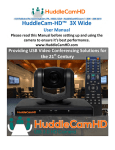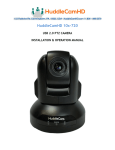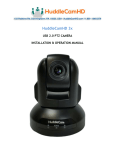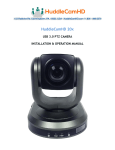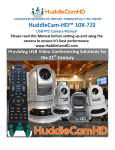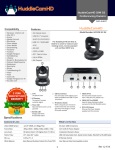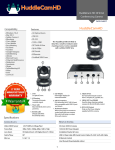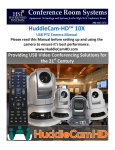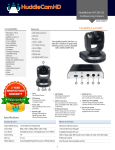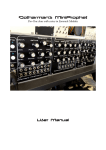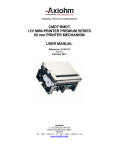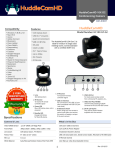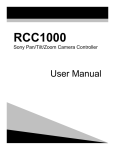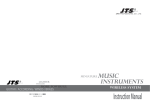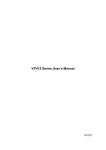Download User Manual - HuddleCamHD
Transcript
HuddleCamHD 3x-Wide USB 3.0 PTZ CAMERA INSTALLATION & OPERATION MANUAL Precautions…………………………………………………………………………………………. Safety Tips……………………………………………………………………………………………. Please read this manual carefully before using the camera. Avoid damage from stress, violent vibration or liquid intrusion during transportation, storage or installation. Take care of the camera during installation to prevent damage to the camera case, ports, lens or PTZ mechanism. Do not apply excessive voltage. (Use only the specified voltage.) Otherwise, you may experience electrical shock. Keep the camera away from strong electromagnetic sources. Do not aim the camera at bright light sources (e.g. bright lights, the sun, etc.) for extended periods of time. Do not clean the camera with any active chemicals or corrosive detergents. Do not disassemble the camera or any of the camera's components. If problems arise, please contact your authorized dealer. After long term operation, moving components can wear down. Contact your authorized dealer for repair. Supplied Accessories……………………………………………………………………………. HD Color Video Camera (1) 12V/2.0A DC Power Adapter (1) Installation Bracket (1) Installation Screw (1) USB 3.0 Data Cable (3m), Serial Control Cable, RS-232C to RS-485 Adaptor IR Remote Controller (1) User Manual (1) Ver 1.2 8/15 Physical Description………………………………………………………………………. 1. Front View…………………………………………………………………………………… 1 1. Lens 2. IR Receiver 2 3 4 2 5 To receive IR remote controller signal. 3. Power LED Blue LED lights when unit is powered and on. 4. Stand by LED Orange LED lights when unit is powered and in standby. 5. IR Receiver To receive IR remote controller signal. Ver 1.2 8/15 2. Rear View…………………………………………………………………………………………. 6 6. 7 8 9 2 10 USB 3.0 Interface For connection to PC USB 3.0 port (also compatible with USB 2.0 port and driver). 7. IR Selective Switch When using only one remote to control more than one camera, this switch will assign a unique ID to each camera. 8. VISCA IN Port For hard wired remote control from a 3rd party PC, joystick, etc... 9. VISCA Out Port/RS485 Used for daisy chaining multiple cameras for RS-232 RS-485 control. 10. DC IN 12V Socket Only use the Power Adapter supplied with this camera. Ver 1.2 8/15 2. BottomView………………………………………………………………………………… 1. Tripod Will accept 1/4-20 bolt from 3rd party tripod, wall or ceiling mount. 2. Dip-Switch Used for selecting baud rate and the remote signal output switch. Ver 1.2 8/15 4. Dip-Switch Settings………………………………………………………………………….. Note: When changing Dip-Switch settings, make all changes with camera powered off. Dip-Switch 1 - (To set communication baud rate). Dip-Switch 2 - (To set control protocol). Dip-Switch 3 - (Set only for firmware upgrading). Dip Switch 4 & 5 - (To set camera’s RS232/RS485 ID number – for daisy chain wired control). Ver 1.2 8/15 Cable Connection Info………………………………………………………………………… VISCA RS-232C - IN Reference……………………………………………………………… VISCA RS-232C - Out Reference…………………………………………………………… Ver 1.2 8/15 OSD MENU…………………………………………………………………………………………….. On Screen Display Menu - Use the OSD menu to access and change the camera’s settings. Note: You cannot manually move the camera (pan/tilt) when the OSD menu is visible on the screen. The Dome OSD Menu is as follows: Pan Speed Default Value: 20 o Set speed of Pan motor Range = 1 - 63 Tilt Speed Default Value: 20 o Set speed of Pan motor Range = 1 – 63 Scan Speed (Auto Pan Mode) Default Value: 6 o Set speed of boundary scan Range = 1 – 63 Tour Path (uses presets) Default Value: 1 o Select desired tour path Range = 1 – 4 Tour Dwell Default o Set duration to dwell on each preset Range = 1 – 60 Proportion Default o Set Proportion Range = On – Off Auto Rev Default o Set camera mounting orientation N for inverted ceiling mount Frame Default o Set Refresh Rate Range = 50Hz or 60 Hz Ver 1.2 8/15 Value: 5 Value: On Value: P Value: 60Hz The Lens OSD Menu is as follows: DISPLAY Default Value: Off On Screen Display o On or Off DZOOM Default Value: Off Enable Digital Zoom o On or Off BACKLIGHT Default Value: OFF o On or Off NR (Noise Reduction) Default Value: 3 Adjustable Value: o 0-5 WB (White Balance) Default Value: Auto Auto/Manual/Outdoor/Indoor/One Push/ATW (Manual Settings): o R GAIN (Red Gain) Default Value: 64 Adjustable Scope: 0-255 o B GAIN (Blue Gain) Default Value: 84 Adjustable Scope: 0-255 AE (Auto Exposure) Default Value: Auto o Auto/Manual (Manual Settings): o SHUTTER Default Value: 1/1 Shutter Speed Range: 1/1-1/10000 o IRIS Default Value: Close Close/F1.4-f22 o BRIGHT o Set Brightness 0 - 31 Ver 1.2 8/15 Default Value: 0 IR Remote Controller 1. 2. 3. 4. 5. (Note: Some buttons do not operate for all camera models) Reset: Restarts the camera and restores it to Factory Default settings. (Note: Will delete all memory). Camera Selection Select Camera ID: 1, 2 or 3 Preset Positions 1-9: Preset Positions Set: Setting Preset Position Clear: Clear Preset Position Call: Call Preset Position Note: If you want to set (or call) the first preset position to 1, you should press number key “1”, then press “Set” (or “Call”) to set (call) the position. Fast Zoom in/out Control Zone +: Zoom in quickly -: Zoom out quickly Pan/Tilt Controller Move Up Move Down Move Left Move Right 6. 7. 8. 9. 10. Auto Pan Additional Function Zone Freeze: Image Freeze BL: Back-light Compensation WB: White Balance AE: Auto Exposure D Zoom: Digital Zoom HDMI: Swap to HDMI video output DVI: Swap to DVI video output Format: Swap between different formats Power Supply Switch Switch for turning camera on (i.e. Stand-By mode vs. Working mode) OSD Menu Zone Dome OSD: Enter Pan Tilt Zoom OSD menu Lens OSD: Enter lens OSD menu Slow Zoom In/Out Zone +: Zoom in slowly -: Zoom out slowly Focus Control Zone Auto: Turn on auto focus Manual: Turn on manual focus Far: Set focus at farther distance Near: Set focus at nearer distance Ver 1.2 8/15 11. Pan/Tilt Function Zone L-Limit: Set left boundary limit scanning position Scan: Enable Boundary Scanning (Auto Panning) R-Limit: Set right boundary limit scanning position Home: Go to camera’s Home position Tour: Enable automatic patrol tour of presets Rev: Enable image flip for ceiling mounting Connection Instructions……………………………………………………………………… 1. Connect included Power Supply to the camera. 2. Wait for camera to come to Home Position. 3. Connect included USB 3.0 cable to camera and USB 3.0 port of PC (unit is also backwards compatible with USB 2.0 port). 4. Select and configure camera in your software of choice. NOTE: Failure to follow this sequence may result in no connection to PC. Care Of The Unit………………………………………………… Remove dust or dirt on the surface of the lens with a blower (commercially available). Ver 1.2 8/15 Installation Instructions……………………………………………………………………… Desktop Installation……………………………………………………………………………… When using the HuddleCam on a desk, Make sure that it will stand level. If you want to use the camera on an incline, make sure the angle is less than 15 degrees to ensure that the camera’s pan and tilt mechanism operates normally. Tripod Installation………………………………………………………………………………… When using the HuddleCamwith a tripod, screw the tripod to the bottom of the camera. The tripod screw must fit below specifications: Note: Tripod must stand on a level surface. Ver 1.2 8/15 Ceiling Mount………………………………………………………………………………………………………… Ceiling Step 1: For hard ceilings Use the supplied plastic anchors and screws to fix the ceiling bracket to the ceiling. Ceiling Bracket For acoustic tile ceilings cut a piece of plywood 12” x 23.75” to use as a tile bridge above the ceiling tile. Use the supplied screws (without plastic anchors) to fix the ceiling bracket to the plywood, sandwiching the ceiling tile in between. Do not over-tighten. NOTE: The four raised areas of the ceiling bracket must face towards the ceiling. Step 2: Slotted bolts Use the two slotted bolts to fix the camera bracket to the bottom of the camera body. The 1/4 -20 bolt is for the threaded insert in the camera body. The smaller bolt threads into the bracket and pins the camera in place using the unthreaded opening on the camera body. Camera Bracket Step 3: Slide the camera bracket assembly on to the ceiling bracket, allowing the 2 slotted bolt heads to fit over the large keyhole opening in the ceiling bracket. Slide the camera and camera bracket until both bolt heads are fitted into the narrower slot of the large keyhole opening. Step 4: Use the locking screw to lock the ceiling and camera brackets together to finish the installation Ver 1.2 8/15 Troubleshooting………….………………………………………………………………………… Problem There is no power to the camera. Camera will not connect to the PC via USB. Camera unable to pan, tilt, and/or zoom. Remote control not working. Camera cannot be controlled via VISCA. The Camera is not working at all. Ver 1.2 8/15 Cause Power adapter is disconnected from mains or from camera. Power switch is set to OFF. USB cable is bad. Camera connects sometimes. Menu is currently displayed on the screen. Pan, tilt or zoom range limit was reached. The “camera select” button on the remote control is not set to match the “IR select” switch number set on the camera. The connection between the PC and camera is incorrect. Commands being sent are incorrect. No response or image from camera. Resolution Check the connections between the camera, power adapter and mains. If anything is disconnected, reconnect it. Set the power switch to ON. Try new USB Cable Connect USB only after camera has completely booted. Retry after exiting the menu. Try to pan/tilt/zoom in the other direction. Choose the correct “IR select” number to match camera settings. Refer to Cable Connection Info section of this manual. Refer to VISCA manual. Disconnect power, and wait a few minutes, then connect the power again. Retry. Important Notes Regarding USB Connectivity: USB 3.0 ports are backwards compatible with USB 2.0 devices. USB 2.0 ports are not completely forward compatible with USB 3.0 devices (some USB 3.0 devices will connect to USB 2.0 with limited functionality). External USB hubs should be avoided (i.e. give the camera its own USB port on the device) as they are not well suited to transmitting HD video reliably. USB extension systems must be fully compatible with the version of USB that you are using and must utilize an external power supply, when required. Caution: Some “compatible” USB 3.0 extenders do not actually have the full 5Gbps bandwidth required for uncompressed HD video – so check bandwidth specs. Always connect the HuddleCam directly to the device in order to associate the UVC drivers before attempting to use any extension system. USB 3.0 power saving settings in the device’s operating system should be turned off completely for reliable USB 3.0 camera connectivity. HuddleCam Cameras All HuddleCamHD cameras utilize the UVC (USB Video Class) drivers that are built into Windows, Mac OS and Linux to stream HD video to your device via your device’s USB port (USB 2.0 or USB 3.0 depending upon HuddleCam model). When your device successfully recognizes the camera, your device will register the HuddleCam as an “imaging device”. You can see this in your Windows Device Manager program (type “device manager” into the Windows search tool) as shown in the screenshot, below: Ver 1.2 8/15 In this example, you can see the HuddleCam model in use connected as a fully functional USB 3.0 device (HuddleCamHD) as well as a USB 2.0 device with limited functionality (USB2.0 Camera). If your device has not connected to or has not recognized the HuddleCam as an imaging device (in which case, you may see a new “unknown device”, “Westbridge” or “CYTFX3” labeled device show up in Device Manager’s “Universal Serial Bus Controllers” section rather than in the “Imaging Devices” section), the HuddleCam will not be available to programs that utilize a camera. In this case, try restarting the device and reconnecting the camera via USB (USB 2.0 or USB 3.0 depending upon HuddleCam model). Ver 1.2 8/15 Similarly, you can see a connected device in System Information on a MAC. See screenshot below: In this example, you can see the HuddleCam model in use connected as a fully functional USB 3.0 device “HuddleCamHD” as well as a “USB2.0 camera” with limited functionality (USB2.0 camera). Ver 1.2 8/15 Specs………….…………………………………………………………………………………………. Model Number: HC3XW-GY-G2 Camera & Lens Video CMOS Sensor Frame Rate Lens Zoom Field of View Min Lux Warranty 1/2.8” CMOS, 2.0 Mega Pixel 30fps 1920 x 1080p, 60fps 1280 x 720p 3X Optical Zoom 12X Digital Zoom f=3.0 to 9.0mm 23° (tele) to 90° (wide) 0.25 at F 1.2 2 years parts and labor Pan/Tilt Movement Pan Movement Tilt Rotation Presets ±355° Up 90°, Down 45° 64 Presets Rear USB 3.0 Mini DIN-8 (VISCA IN, VISCA OUT/RS485) Dip-Switch Pin 7/TTL Signal 9600 bds DC 12V 2A Board Connectors High Definition Interface Controller Signal Interface Controller Signal Config. Baud Rate Power Supply Interface Electrical Index Power Supply Adapter Input Voltage Input Power Power Supply Max Temp 12V DC 2A 12V DC (10.5-14V DC) 24W (Max) -14°F to 140°F Physical Material Dimensions (W x H x D) mm Camera Weight Box Dimensions Boxed Weight Temperature Color Operating Temperature Storage Temperature Working Environment Aluminum, Plastic 5.68”W x 6.38”H x 5.88”D (7.13” H w/ tilt up) 139mm x 152mm x 165mm (181mm H w/ tilt up) 2.10 lbs (.95 kg) 13.25”x9.25”x9.5” (336mm x 234mm x 241mm) 5.45 lbs (2.47 kg) 32°F to + 113°F Silver Gray 32°F to + 113°F (0°C to +45°C) -14°F to 140°F (-10°C +60°C) Indoor only



















